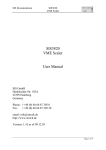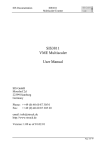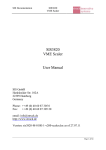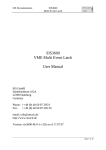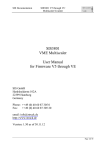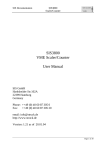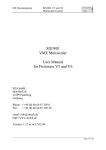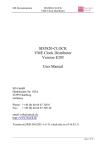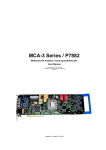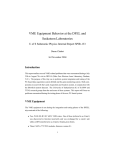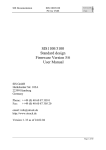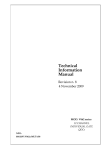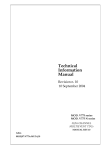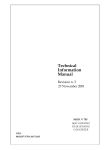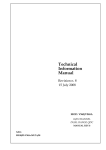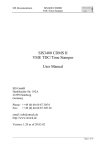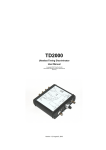Download SIS3820 VME Scaler User Manual
Transcript
SIS Documentation SIS3820 VME Scaler SIS3820 VME Scaler User Manual SIS GmbH Harksheider Str. 102A 22399 Hamburg Germany Phone: ++49 (0) 40 60 87 305 0 Fax: ++49 (0) 40 60 87 305 20 email: [email protected] http://www.struck.de Version: 1.00 as of 24.06.03 Page 1 of 72 SIS Documentation SIS3820 VME Scaler Revision Table: Revision 0.0x 0.10 1.00 Page 2 of 72 Date 13.02.02 23.06.03 24.06.03 Modification Start of module definition Prerelease First official release SIS Documentation SIS3820 VME Scaler 1 Table of contents 1 2 Table of contents ................................................................................................................. 3 Introduction ......................................................................................................................... 7 2.1 3 4 Implementation note firmware version 3820 01 01 .................................................................................7 Technical Properties/Features ............................................................................................. 8 Functionality........................................................................................................................ 9 4.1 Block Diagram.........................................................................................................................................9 4.2 Modes of operation ................................................................................................................................10 4.2.1 Scaler/Counter ...................................................................................................................................10 4.2.2 Latching Scaler ..................................................................................................................................10 4.2.3 Preset Scaler ......................................................................................................................................10 4.2.4 Multi channel Scaler (MCS) .............................................................................................................10 4.2.5 Histogramming Scaler(not in 3820 01 01 design) .............................................................................10 5 Getting started ................................................................................................................... 11 5.1 Installation .............................................................................................................................................11 5.2 LINUX example/test code .....................................................................................................................11 5.3 Initial VME access test ..........................................................................................................................11 5.3.1 User LED test ....................................................................................................................................11 5.3.2 Readout of Module Id. and firmware revision register ......................................................................11 5.3.3 Standard Counter ...............................................................................................................................12 5.3.4 Multiscaler (MCS) .............................................................................................................................13 5.3.5 Preset Scaler ......................................................................................................................................14 6 VME Addressing............................................................................................................... 15 6.1 7 Address map ..........................................................................................................................................16 Register description........................................................................................................... 18 7.1 Control/Status Register(0x, write/read) .................................................................................................19 7.1.1 Counter test mode ..............................................................................................................................20 7.1.2 25 MHz test pulse mode ....................................................................................................................20 7.1.3 Reference pulser channel 1 ................................................................................................................20 7.2 Module Id. and Firmware Revision Register (0x4, read).......................................................................21 7.2.1 Major revision numbers .....................................................................................................................21 7.3 Interrupt configuration register (0x8) ....................................................................................................22 7.3.1 IRQ mode ..........................................................................................................................................22 7.4 Interrupt Control/Status register (0xC) ..................................................................................................23 7.4.1 Interrupt sources ................................................................................................................................24 7.5 (0x10)Acquisition preset register...........................................................................................................26 7.6 Acquisition count register (0x14) ..........................................................................................................26 7.7 LNE Prescaler factor register (0x18) .....................................................................................................27 7.8 Preset value register counter group 1 (0x20) .........................................................................................28 7.9 Preset value register counter group 2 (0x24) .........................................................................................28 7.10 Preset Enable and Hit register (0x28) ....................................................................................................28 7.11 CBLT/Broadcast setup register..............................................................................................................29 7.12 SDRAM page register (0x34) ................................................................................................................30 7.13 FIFO word counter/memory address pointer register (0x38) ................................................................31 7.14 FIFO word counter threshold (0x3C) ....................................................................................................32 7.15 (Acquisition) Operation Mode register (0x100) ....................................................................................33 7.15.1 Modes of Operation modes............................................................................................................33 7.15.2 Input modes ...................................................................................................................................34 7.15.3 Output mode ..................................................................................................................................35 7.15.4 SDRAM mode ...............................................................................................................................35 7.15.5 Arm/enable source .........................................................................................................................36 7.15.6 LNE source ....................................................................................................................................36 7.15.7 Data format ....................................................................................................................................37 7.15.8 Clearing/non clearing.....................................................................................................................37 7.16 Copy disable register (0x104)................................................................................................................38 7.17 LNE channel select register (0x108) .....................................................................................................39 Page 3 of 72 SIS Documentation SIS3820 VME Scaler 7.18 PRESET channel select register (0x10C) ..............................................................................................40 7.18.1 Preset scheme.................................................................................................................................40 7.19 Inhibit/count disable register (0x200)....................................................................................................41 7.20 Counter clear register (0x204) ...............................................................................................................41 7.21 Counter Overflow register (0x208)........................................................................................................41 7.22 One wire Id. register (tbd) .....................................................................................................................42 7.23 FIFO address space (0x80000-0xFFFFFC) ...........................................................................................43 7.23.1 non incrementing VME master......................................................................................................43 7.23.2 incrementing VME master.............................................................................................................43 7.24 SDRAM address space (0x80000-0xFFFFFC)......................................................................................43 8 Data Format....................................................................................................................... 44 8.1 8.2 8.3 8.4 9 32-bit Mode ...........................................................................................................................................44 24-bit Mode ...........................................................................................................................................44 16-bit Mode ...........................................................................................................................................45 8-bit Mode .............................................................................................................................................45 Front panel elements ......................................................................................................... 46 9.1 Front Panel Layout ................................................................................................................................46 9.2 Front Panel LEDs ..................................................................................................................................47 9.3 Flat cable Input/Output Pin Assignments ..............................................................................................48 9.3.1 ECL....................................................................................................................................................48 9.3.2 TTL....................................................................................................................................................49 10 Board Layout..................................................................................................................... 50 11 Jumper settings/pinouts ..................................................................................................... 51 11.1 11.2 11.3 11.4 J1 ...........................................................................................................................................................51 J90 .........................................................................................................................................................51 JP570 JTAG source ...............................................................................................................................52 CON500 JTAG ......................................................................................................................................52 12 Input Configuration ........................................................................................................... 53 12.1 ECL........................................................................................................................................................53 12.2 LVDS.....................................................................................................................................................54 12.3 NIM .......................................................................................................................................................55 12.4 TTL........................................................................................................................................................56 12.4.1 TTL/LEMO ...................................................................................................................................56 12.4.2 TTL/Flat Cable ..............................................................................................................................56 13 Signal Specification........................................................................................................... 57 13.1 13.2 13.3 Control Signals ......................................................................................................................................57 Inputs .....................................................................................................................................................57 User Bits ................................................................................................................................................57 14 Theory of operation........................................................................................................... 58 14.1 Enable Logic..........................................................................................................................................58 14.2 Read on the fly.......................................................................................................................................59 14.3 Latching scaler.......................................................................................................................................59 14.4 Preset Scaling ........................................................................................................................................59 14.5 Multiscaling (MCS) ...............................................................................................................................60 14.5.1 Minimum dwell time .....................................................................................................................60 14.5.2 arm/enable with MCS ....................................................................................................................61 14.6 Clearing/non clearing mode...................................................................................................................61 14.7 CBLT readout(not implemented in 3820 01 01 firmware) ....................................................................62 14.7.1 CBLT Setup example.....................................................................................................................63 14.7.2 CBLT hints ....................................................................................................................................64 15 Appendix ........................................................................................................................... 65 15.1 P2 row A/C pin assignments..................................................................................................................65 15.2 Row d and z Pin Assignments ...............................................................................................................66 15.3 Connector Types....................................................................................................................................67 15.4 Power consumption ...............................................................................................................................67 15.5 Operating conditions..............................................................................................................................67 15.5.1 Cooling ..........................................................................................................................................67 15.5.2 Hot swap/live insertion ..................................................................................................................67 Page 4 of 72 SIS Documentation 15.6 15.7 15.8 SIS3820 VME Scaler LED (selftest) ........................................................................................................................................67 VME readout performance ....................................................................................................................68 Software Support ...................................................................................................................................68 16 Glossary............................................................................................................................. 69 17 Index.................................................................................................................................. 70 Page 5 of 72 SIS Documentation Page 6 of 72 SIS3820 VME Scaler SIS Documentation SIS3820 VME Scaler 2 Introduction The SIS3820 is a multi purpose counter. It combines the functionality of the SIS3800 scaler and the SIS3801 multiscaler with extended funtions. The proven concept of flexible leaded component based frontend circuitry in conjunction with more recent FPGA (field programmable gate array) technology results in unprecedented flexibility to implement the given readout application. Applications comprise, but are not limited to: • • • • • • • Nuclear Phyics Particle Physics Neutrino/Astrophysics Synchrotron Radiation Neutron Scattering Machine (accelerator) diagnosis Scanning microscope readout 2.1 Implementation note firmware version 3820 01 01 Following functions are foreseen for future implementation but not part of the initial 01 01 SIS3820 design yet: • Firmware upgrade from VME • CBLT • Histogramming scaler/add mode • One wire Id. support • Support for 512 and 1024 MB memory strips The firmware can be readily upgraded in field at a later point in time. Page 7 of 72 SIS Documentation SIS3820 VME Scaler 3 Technical Properties/Features This manual describes the implemented functionality for the SIS3820-SCALER firmware. Other firmware designs are SIS3820-CLOCK (clock distributor for up to 32 SIS330x VE digitizers) and SIS3820-LATCH (input register with counter and interrupt functionality) Find below a list of key features of the SIS3820. • 32 channels (64 channel option) • 4 front panel control inputs • 4 front panel control outputs • 64 Mbytes SDRAM (512/1024 MB option) • 250 MHz counting rate (ECL and NIM), 100 MHz for TTL (50 MHz for P2 fed channels) • 32-bit counter depth • NIM/TTL/ECL/LVDS versions • flat cable (ECL, TTL and LVDS) and LEMO (TTL/NIM) options • multi channel, latching and preset scaler operation • shadow register (latching scaler mode) • read on the fly (latching scaler mode) • reference pulser • test pulser • A24/32 D32/BLT32/MBLT64/2eVME/CBLT • Geographical addressing mode (in conjunction with VME64x backplane) • Interrupt capabilities • Hot swap (in conjunction with VME64x backplane) • VME64x Connectors • VME64x Side Shielding • VME64x Front panel • VME64x extractor handles (on request) • single supply (+5 V) • in field firmware upgrade capability Page 8 of 72 SIS Documentation SIS3820 VME Scaler 4 Functionality The functionality of the SIS3820 is a combination of hardware (printed circuit board) design, stuffing options and firmware. The module consists of two FPGAs that hold the frontend logic and on FPGA that holds the VME interface, the SDRAM controller and the control logic functions. Logic level adaptation is handled by classic DIL components and single inline (SIL) resistor networks. The firmware is loaded from a serial PROM at power up. Both JTAG and VME can be used for in field firmware upgrades/changes. Block Diagram 4x Level Adaptation Driver/Receiver 4x Level Adaptation Driver/Receiver VME and Control FPGA 4x Level Adaptation Driver/Receiver 4x Level Adaptation Driver/Receiver 4x Level Adaptation Driver/Receiver 4x Level Adaptation Driver/Receiver 4x Level Adaptation Driver/Receiver 4x Level Adaptation Driver/Receiver 4x Level Adaptation Driver/Receiver 4x Level Adaptation Driver/Receiver Frontend FPGA Driver/Receiver 16 x Frontend FPGA Driver/Receiver 16 x VME P1 and P2 SDRAM P2 (A,C) 4.1 Page 9 of 72 SIS Documentation 4.2 SIS3820 VME Scaler Modes of operation 4.2.1 Scaler/Counter In standard counter/scaler mode data can be read on the fly with an accuracy to the least significant bit. No counts are lost in read on the fly mode. 4.2.2 Latching Scaler In latching scaler mode scaler values are copied to a shadow register set upon a front panel signal LNE or a VME command. Broadcast functionality is implemented for the later to allow for minimum time difference over a set of several SIS3820s without front panel cabling. 4.2.3 Preset Scaler The SIS3820 can be operated as preset scaler. An arbitrary channel or a combination of channels can be selected as the condition for the termination of the counting process. The selection of the channel(s) is done via the preset enable mask register . The first selected channel that reaches its preset value will terminate the counting process. The actual preset values are defined though the preset value register set. The internal 25 MHz pulse generator (or a prescaled derived output) can be used as time base for measurements if its enabled for channel 1 with this channel being enabled in the preset enable mask and the desired prescale factor stored into the channel 1 preset value register. The terminating channel can be identified by the actual scaler data or the preset hit mask register if more than one preset channel is enabled. 4.2.4 Multi channel Scaler (MCS) MCS mode allows for the buffered readout of variable or fixed lengths counting time intervals. The interval length can be defined by an internal timer as well as by an external signal, which can be prescaled also. The minimum buffer memory size of 64 MB takes the realtime burden away from the VME master even at very short time intervals (dwell times). Two factors facilitate short dwell time applications. The first is high speed VME readout of data from SDRAM in MBLT64 and 2eVME. The second is data compression with a reduction in counter depth to 16 or 8-bit. Data compression is also a good way to save VME bandwidth in lower count rate applications (with V/F converters e.g.) at longer dwell times. 4.2.5 Histogramming Scaler(not in 3820 01 01 design) Histogramming scaler mode (MCS mode with add enabled) allows to acquire and add MCS data of several repeated scans in SDRAM without CPU interaction. The user has to make sure, that the reset to the first bin and the number of bins are issued with the accuracy that is required by the application. I.e. no number of bin/reset checking mechanism is implemented (unlike in the SIS3100-HISCAL DSP based design). Page 10 of 72 SIS Documentation SIS3820 VME Scaler 5 Getting started This section is intended for the first time SIS3820 user. In some cases it may be good enough to use the provided header file and C examples to get acquainted to a couple of the modules functions before looking at the other sections of the manual in more detail. If you have a SIS1100/3100 PCI to VME interface under LINUX or under Win2K/XP with Visual C++ you can use the provided example code without modifications. 5.1 Installation • Select addressing A32 or geographical address mode with J1 (factory default is A32) • Select base address with SW3 and SW4 in non geographical addressing (the default base address setting is 0x38000000) • turn VME crate power off • install your SIS3820 board in the VME crate • connect inputs • turn VME crate power back on • verify, that the P (power) and R (ready) LEDs are on and all other LEDs are off after the approximately 2s long power up self test cycle 5.2 LINUX example/test code The file sis3820.tar.gz holds 5 LINUX example programs, the sis3820.h header file and a Makefile to generate the executables. 5.3 Initial VME access test Both the user LED and readout of the Module Id. and firmware register provide a good way to verify that proper initial communciation with the SIS3820 can be established. 5.3.1 User LED test The program sis3820_led.c runs 30 cycles with the sequence user LED on, sleep(1), user LED off, sleep(1). 5.3.2 Readout of Module Id. and firmware revision register The program sis3820_readmodid.c reads and displays the module identification and firmware register. mki@mki:~/sis1100/sis3820> ./sis3820_readmodid Module identification and firmware register reads: 38200101 Page 11 of 72 SIS Documentation SIS3820 VME Scaler 5.3.3 Standard Counter In the minimum counter application you enable the logic, have the module count for a period of time and read out the scaler values after disabling the logic. The sis3820_counter program runs 2 counting cycles of 5 s each. During the second cycle the internal 50 MHz reference pulse generator is routed to channel 1. Sample output with a 11 MHz signal connected to scaler channel 17 is shown below. mki@mki:~/sis1100/sis3820> ./sis3820_counter SIS3820 scaler counting gotwords 32 scaler data ch01 00000000 ch02 00000000 ch03 00000000 ch05 00000000 ch06 00000000 ch07 00000000 ch09 00000000 ch10 00000000 ch11 00000000 ch13 00000000 ch14 00000000 ch15 00000000 ch17 03477ce7 ch18 00000000 ch19 00000000 ch21 00000000 ch22 00000000 ch23 00000000 ch25 00000000 ch26 00000000 ch27 00000000 ch29 00000000 ch30 00000000 ch31 00000000 now with reference pulser on ch1 enabled SIS3820 scaler counting gotwords 32 scaler data ch01 0eedfb33 ch02 00000000 ch03 00000000 ch05 00000000 ch06 00000000 ch07 00000000 ch09 00000000 ch10 00000000 ch11 00000000 ch13 00000000 ch14 00000000 ch15 00000000 ch17 0348d70d ch18 00000000 ch19 00000000 ch21 00000000 ch22 00000000 ch23 00000000 ch25 00000000 ch26 00000000 ch27 00000000 ch29 00000000 ch30 00000000 ch31 00000000 ch04 ch08 ch12 ch16 ch20 ch24 ch28 ch32 00000000 00000000 00000000 00000000 00000000 00000000 00000000 00000000 ch04 ch08 ch12 ch16 ch20 ch24 ch28 ch32 00000000 00000000 00000000 00000000 00000000 00000000 00000000 00000000 Note: The 50 MHz reference pulse generator will give you an idea on the sleep/scheduling accuracy of your LINUX system. Page 12 of 72 SIS Documentation SIS3820 VME Scaler 5.3.4 Multiscaler (MCS) MCS mode is demonstrated with the program sis3820_mcs.c. With respect to the fact that SDRAM mode with a fixed number of acquisitions is used, its kind of a minimum approach that does not make use of the full capabilities of the SIS3820. The example uses the internal 10 MHz LNE source, which is run through the LNE prescaler to minimize the need for external signals. The number of acquisitions is preset with the acquisition preset register. The acquisition count register is used to determine completion of the acquisition process. Find below the output of the program for 11 LNEs (corresponding to 11 time slices) with an input rate of 11 MHz moved across scaler channel 1 to channel 4 as the MCS acquisition is going on. Note that the CLR LED is pulsed with every LNE and that the S LED is on from the enable command until the acquisition preset has been reached. mki@mki:~/sis1100/sis3820> ./sis3820_mcs MCS mode, scan 1 completed MCS mode, scan 2 completed MCS mode, scan 3 completed MCS mode, scan 4 completed MCS mode, scan 5 completed MCS mode, scan 6 completed MCS mode, scan 7 completed MCS mode, scan 8 completed MCS mode, scan 9 completed MCS mode, scan 10 completed gotwords 40 scaler data scan: 001 ch01 00a7d8f7 ch02 00000000 ch03 scan: 002 ch01 00a7d8f7 ch02 00000000 ch03 scan: 003 ch01 008f5010 ch02 00000000 ch03 scan: 004 ch01 00000000 ch02 003d3c9f ch03 scan: 005 ch01 00000000 ch02 00a7d8f7 ch03 scan: 006 ch01 00000000 ch02 002255a6 ch03 scan: 007 ch01 00000000 ch02 00000000 ch03 scan: 008 ch01 00000000 ch02 00000000 ch03 scan: 009 ch01 00000000 ch02 00000000 ch03 scan: 010 ch01 00000000 ch02 00000000 ch03 00000000 00000000 00000000 00000000 00000000 00000000 006ee942 0076e9f4 00000000 00000000 ch04 ch04 ch04 ch04 ch04 ch04 ch04 ch04 ch04 ch04 00000000 00000000 00000000 00000000 00000000 00000000 00000000 00000000 00438a6e 00a7d8f7 Page 13 of 72 SIS Documentation SIS3820 VME Scaler 5.3.5 Preset Scaler The sis3820_preset example illustrates preset scaling. Counter group 1 is activated for preset scaling with channel 4 selected as preset channel. A value of 0x1000000 is written to the preset value register of counter group 1 and the logic enabled afterwards. The status of the preset enable and hit register is polled until channel group 1 has reached its preset value. mki@mki:~/sis1100/sis3820> ./sis3820_preset gotwords 32 scaler data ch01 00000000 ch02 00000000 ch03 00000000 ch05 00000000 ch06 00000000 ch07 00000000 ch09 00000000 ch10 00000000 ch11 00000000 ch13 00000000 ch14 00000000 ch15 00000000 ch17 00000000 ch18 00000000 ch19 00000000 ch21 00000000 ch22 00000000 ch23 00000000 ch25 00000000 ch26 00000000 ch27 00000000 ch29 00000000 ch30 00000000 ch31 00000000 mki@mki:~/sis1100/sis3820> ch04 ch08 ch12 ch16 ch20 ch24 ch28 ch32 01000002 00000000 00000000 00000000 00000000 00000000 00000000 00000000 Note: It will take in the order of 140 ns after the preset condition was detected before the counter will stop counting. This implies, that the actual stored counter value will be greater than the preset value for frequencies in excess of some 7 MHz. Above output was generated with a symmetric 15 MHz source e.g. Page 14 of 72 SIS Documentation SIS3820 VME Scaler 6 VME Addressing As the SIS3820 features memory options with up 512 Mbytes of SDRAM, A32 addressing was implemented as the only option. Hence the module occupies an address space of 0xFFFFFF Bytes (i.e. 16 MBytes). The SIS3820 firmware addressing concept is a pragmatic approach to combine standard rotary switch style settings with the use of VME64x backplane geographical addressing functionality. The base address is defined by the selected addressing mode, which is defined by jumper array J1 and possibly SW4 and SW3 (in non geographical mode). J1 Function EN_A32 reserved EN_GEO reserved EN_A32 EN_GEO Description 0 0 non A32 addressing, reserved for future use 0 1 non A32 addressing, reserved for future use 1 0 A32 addressing, address compared with SW3/SW4 1 1 A32 addressing, address compared with geographical address 0: jumper open, 1: jumper closed The table below illustrates the possible base address settings. Shorthand SW3/SW4 y GA0-GA4 GA0 GA1 GA2 GA3 GA4 y y x Bits 31 30 29 28 27 26 25 24 SW4 SW3 y J1 Setting GEO - Explanation Setting of rotary switch SW3 or SW4 respective don’t care Geographical address bit as defined by the VME64x(P) backplane Notes: • This concept allows the use of the SIS3820 in standard VME as well as in VME64x environments, i.e. the user does not have to use a VME64x backplane. • The factory default setting is 0x38000000 (i.e. SW4=3, SW3=8, EN_A32 closed and EN_GEO open/disabled) Page 15 of 72 SIS Documentation 6.1 SIS3820 VME Scaler Address map Offset 0x0 0x4 0x8 0xC 0x10 0x14 0x18 R/W R/W R/W R/W R/W R/W R R/W Mode D32 D32 D32 D32 D32 D32 D32 0x20 0x24 0x28 R/W R/W R/W D32 D32 D32 Preset value register counter group 1 (1 to 16) Preset value register counter group 2 (17 to 32) Preset enable and hit register 0x30 0x34 0x38 0x3C R/W R/W R/W R/W D32 D32 D32 D32 CBLT/Broadcast setup register SDRAM page register FIFO Word count register FIFO Word count threshold register 0x100 0x104 0x108 0x10C R/W R/W R/W R/W D32 D32 D32 D32 (Acquisition) Operation mode register Copy disable register LNE channel select register (1 of 32) PRESET channel select register ( 2 times 1 out of 16) 0x200 0x204 0x208 0x20C R/W W R/W R D32 D32 D32 D32 Inhibit/count disable register Counter Clear register Counter Overflow read and clear register Johnson error register (SIS internal use) future use future use future use R/W R/W R/W 0x400 0x404 0x408 0x414 KA KA KA KA D32 (broadcast) D32 (broadcast) D32 (broadcast) D32 (broadcast) Key reset Key SDRAM/FIFO reset Key test pulse Key Counter Clr 0x410 0x414 0x418 0x41C KA KA KA KA D32 (broadcast) D32 (broadcast) D32 (broadcast) D32 (broadcast) Key VME LNE/clock shadow Key operation arm Key operation enable Key operation disable 0x800 to 0x87C 0xA00 to 0xA7C R R R W D32/BLT32/CBLT D32/BLT32/CBLT D32/BLT32/CBLT D32/BLT32 R D32/BLT32/ MBLT64/2eVme CBLT32 0x800000 to 0xfffffc Page 16 of 72 Function/Register Control/Status register Module Id. and firmware revision register Interrupt configuration register Interrupt control/status register Acquisition preset register Acquisition count register LNE prescale factor register One wire Id. register XILINX JTAG SDRAM Prom Shadow registers Counter registers FIFO address space in FIFO emulation mode SDRAM or FIFO space array (address window for page of 8 Mbytes) SIS Documentation SIS3820 VME Scaler Note: SDRAM (FIFO respective ) write access with active MCS mode will result in a VME bus error. In MCS mode the memory is reserved for storage of the counter values. The shorthand KA stands for key address. Write access with arbitrary data to a key address initiates the specified function Page 17 of 72 SIS Documentation SIS3820 VME Scaler 7 Register description The function of the individual registers is described in detail in this section. The first line after the subsection header (in Courier font) like: #define SIS3820_CONTROL_STATUS refers to the sis3820.h header file. Page 18 of 72 0x0 /* read/write; D32 */ SIS Documentation 7.1 SIS3820 VME Scaler Control/Status Register(0x, write/read) #define SIS3820_CONTROL_STATUS 0x0 /* read/write; D32 */ The control register is in charge of the control of some basic properties of the SIS3820 board, like enabling test pulse generators. It is implemented via a selective J/K register, a specific function is enabled by writing a 1 into the set/enable bit, the function is disabled by writing a 1 into the clear/disable bit (which location is 16-bit higher in the register). An undefined toggle status will result from setting both the enable and disable bits for a specific function at the same time. On read access the same register represents the status register. Bit 31 write Function 30 29 28 27 26 25 24 23 22 21 20 19 18 17 16 15 14 13 12 11 10 9 8 7 6 5 4 3 2 1 0 switch off reference pulser channel 1 (*) counter test mode (*) clear 25MHz test pulses (*) switch off user LED (*) switch on reference pulser channel 1 enable counter test mode enable 25MHz test pulses switch on user LED read Function Status external LATCH Bit2 (depend from Input Mode) Status external LATCH Bit1 (depend from Input Mode) Status external Input Bit2 (depend from Input Mode) Status external Input Bit1 (depend from Input Mode) Overflow 0 0 Status Operation Armed Status Operation SDRAM/FIFO Test Enabled 0 0 0 0 Status Operation MCS Enabled (Active) 0 Status Operation Scaler Enabled (Active) 0 0 0 0 0 0 0 0 0 Status reference pulser Status counter test mode enable Status 25MHz test pulses 0 0 0 Status User LED (1=LED on, 0=LED off) (*) denotes power up default setting, i.e. the power up reading of the register is 0x0 Page 19 of 72 SIS Documentation SIS3820 VME Scaler 7.1.1 Counter test mode VME Key test pulse signals will be counted by all (non inhibited) counters in test mode. Counter test mode has to be activated for 25 MHz test pulse operation also. 7.1.2 25 MHz test pulse mode All (non inhibited) scaler channels will count 25 MHz test pulses if this bit and the counter test mode bit is set. 7.1.3 Reference pulser channel 1 Channel 1 will count 50 MHz reference pulses (precision defined by the on board 100 ppm 50 MHz quarz) if this bit is set. Note: test mode has priority over reference pulser, i.e. reference pulses will not be counted if test mode (with or without 25 MHz test pulse mode) is active. Page 20 of 72 SIS Documentation 7.2 SIS3820 VME Scaler Module Id. and Firmware Revision Register (0x4, read) #define SIS3820_MODID 0x4 /* read only; D32 */ This register reflects the module identification of the SIS3820 and its minor and major firmware revision levels. The major revision level will be used to distinguish between substantial design differences and experiment specific designs, while the minor revision level will be used to mark user specific adaptations. Bit 31 30 29 28 27 26 25 24 23 22 21 20 19 18 17 16 15 14 13 12 11 10 9 8 7 6 5 4 3 2 1 0 Function Module Id. Bit 15 Module Id. Bit 14 Module Id. Bit 13 Module Id. Bit 12 Module Id. Bit 11 Module Id. Bit 10 Module Id. Bit 9 Module Id. Bit 8 Module Id. Bit 7 Module Id. Bit 6 Module Id. Bit 5 Module Id. Bit 4 Module Id. Bit 3 Module Id. Bit 2 Module Id. Bit 1 Module Id. Bit 0 Major Revision Bit 7 Major Revision Bit 6 Major Revision Bit 5 Major Revision Bit 4 Major Revision Bit 3 Major Revision Bit 2 Major Revision Bit 1 Major Revision Bit 0 Minor Revision Bit 7 Minor Revision Bit 6 Minor Revision Bit 5 Minor Revision Bit 4 Minor Revision Bit 3 Minor Revision Bit 2 Minor Revision Bit 1 Minor Revision Bit 0 Reading 3 8 2 0 7.2.1 Major revision numbers Find below a table with major revision numbers used/reserved to date Major revision number 0x01 0xE0 0xF0 Application/user Generic SIS3820 32 channel scaler design SIS3820-CLOCK SIS3820-LATCH Page 21 of 72 SIS Documentation 7.3 SIS3820 VME Scaler Interrupt configuration register (0x8) #define SIS3820_IRQ_CONFIG 0x8 /* read/write; D32 */ In conjunction with the interrupt control register this read/write register controls the VME interrupt behaviour of the SIS3820. Eight interrupt sources are foreseen, for the time being four of them are associated with an interrupt condition, the others are reserved for future use. The interrupter type is DO8 . 7.3.1 IRQ mode In RORA (release on register access) mode the interrupt will be pending until the IRQ source is cleared by specific access to the corresponding disable VME IRQ source bit. After the interrupt is serviced the source has to be activated with the enable VME IRQ source bit again. In ROAK (release on acknowledge) mode , the interrupt condition will be cleared (and the IRQ source disabled) as soon as the interrupt is acknowledged by the CPU. After the interrupt is serviced the source has to be activated with the enable VME IRQ source bit again. ROAK IRQ mode can be used in conjunction with the University of Bonn LINUX Tundra Universe II driver by Dr. Jürgen Hannappel on Intel based VME SBCs. Bit 31 ... 16 15 14 13 12 11 10 9 8 7 6 5 4 3 2 1 0 Function RORA/ROAK Mode (0: RORA; 1: ROAK) VME IRQ Enable (0=IRQ disabled, 1=IRQ enabled) VME IRQ Level Bit 2 VME IRQ Level Bit 1 VME IRQ Level Bit 0 IRQ Vector Bit 7; placed on D7 during VME IRQ ACK cycle IRQ Vector Bit 6; placed on D6 during VME IRQ ACK cycle IRQ Vector Bit 5; placed on D5 during VME IRQ ACK cycle IRQ Vector Bit 4; placed on D4 during VME IRQ ACK cycle IRQ Vector Bit 3; placed on D3 during VME IRQ ACK cycle IRQ Vector Bit 2; placed on D2 during VME IRQ ACK cycle IRQ Vector Bit 1; placed on D1 during VME IRQ ACK cycle IRQ Vector Bit 0; placed on D0 during VME IRQ ACK cycle The power up default value reads 0x 00000000 Page 22 of 72 Default 0 0 0 0 0 0 0 0 0 0 0 0 0 0 0 0 0 0 0 SIS Documentation 7.4 SIS3820 VME Scaler Interrupt Control/Status register (0xC) #define SIS3820_IRQ_CONTROL 0xC /* read/write; D32 */ The interrupt sources are enabled with the interrupt control register. The interrupt source is cleared in the interrupt service routine. The status internal IRQ flag can be used for tests without activating VME interrupt generation. It is set whenever an interrupt would be generated if interrupting would be enabled in the interrupt configuration register. fourth condition is reserved for future use. Bit 31 30 29 28 27 26 25 24 23 22 21 20 19 18 17 16 15 14 13 12 11 10 9 8 7 6 5 4 3 2 1 0 Function (w) 1 Shot : IRQ_UPDATE unused unused unused unused unused unused unused Clear IRQ source 7 Clear IRQ source 6 Clear IRQ source 5 Clear IRQ source 4 Clear IRQ source 3 Clear IRQ source 2 Clear IRQ source 1 Clear IRQ source 0 Disable IRQ source 7 Disable IRQ source 6 Disable IRQ source 5 Disable IRQ source 4 Disable IRQ source 3 Disable IRQ source 2 Disable IRQ source 1 Disable IRQ source 0 Enable IRQ source 7 Enable IRQ source 6 Enable IRQ source 5 Enable IRQ source 4 Enable IRQ source 3 Enable IRQ source 2 Enable IRQ source 1 Enable IRQ source 0 (r) Status IRQ source 7 (reserved) Status IRQ source 6 (reserved) Status IRQ source 5 (reserved) Status IRQ source 4 (FIFO almost full) Status IRQ source 3 (overflow) Status IRQ source 2 (acquisition completed) Status IRQ source 1 (FIFO threshold) Status IRQ source 0 (LNE/clock shadow) Status flag source 7 Status flag source 6 Status flag source 5 Status flag source 4 Status flag source 3 Status flag source 2 Status flag source 1 Status flag source 0 Status VME IRQ Status internal IRQ 0 0 0 0 0 0 Status enable source 7 (read as 1 if enabled, 0 if disabled) Status enable source 6 (read as 1 if enabled, 0 if disabled) Status enable source 5 (read as 1 if enabled, 0 if disabled) Status enable source 4 (read as 1 if enabled, 0 if disabled) Status enable source 3 (read as 1 if enabled, 0 if disabled) Status enable source 2 (read as 1 if enabled, 0 if disabled) Status enable source 1 (read as 1 if enabled, 0 if disabled) Status enable source 0 (read as 1 if enabled, 0 if disabled) Default 0 0 0 0 0 0 0 0 0 0 0 0 0 0 0 0 0 0 0 0 0 0 0 0 0 0 0 0 0 0 0 The power up default value reads 0x 00000000 Note: The clear IRQ source bits are relevant for edge sensitive IRQs only Page 23 of 72 SIS Documentation SIS3820 VME Scaler The generation of the status flags, the IRQ flags and the actual IRQ is illustrated with the schematic below: IRQ ACK cycle Status FLAG Source 0 Source 0 Clear Source 1 AND Status IRQ Source 0 Enable 0 Status FLAG Source 1 Status FLAG Source 7 Source 7 O R IRQ_Update AND Clear Status IRQ Source 1 Enable 1 Clear VME IRQ enable OR internal VME_IRQ IRQ (ROAK case) AND MUX AND Status IRQ Source 7 VME IRQ AND IRQ (RORA case) Enable 7 Note: Source 0 is shown as edge sensitive and source 1 as level sensitive input in the drawing above. Which interrupt sources are edge and level sensitive may vary from firmware implementation to firmware implementation. 7.4.1 Interrupt sources A short explanation of the implemented interrupt sources is given in the following subsections. 7.4.1.1 LNE/clock shadow (IRQ source 0; edge sensitive) In multiscaler or multi channel scaler (MCS) mode interrupt source 0 is associated to the LNE (load next event) signal. The interrupt is issued whenever a LNE signal triggers scaler value transfer to memory. The interrupt will be induced by the rundown of the preset value if LNE prescaling is active. In scaler mode the LNE interrupt is driven by the clock shadow signal . 7.4.1.2 FIFO threshold (IRQ source 1; level sensitive) The FIFO threshold IRQ source can be used for efficient readout in FIFO emulation mode. The interrupt will be triggered as soon as the number of data words in memory will exceed the (non 0) value of the FIFO threshold register 7.4.1.3 Acquisition completed (IRQ source 2; edge sensitive) The number of counting periods to acquire data can be defined with the acquisition preset register in MCS mode.. The acquisition completed interrupt source can be used to trigger an interrupt with this condition. Page 24 of 72 SIS Documentation SIS3820 VME Scaler 7.4.1.4 Overflow (IRQ source 3; level sensitive) The overflow interrupt source is triggered if one or more counters exceed the 32-bit range. The overflow registers can be used to identify the channel that has caused the interrupt. Overflow interrupt generation is active in non clearing mode only. 7.4.1.5 FIFO almost full (IRQ source 4; edge sensitive) This interrupt source can be used to catch the FIFO almost full error condition. It is set if the fill level of the SDRAM exceeds 64 MB-512 words in FIFO mode. The condition has to be resolved by a KEY_SDRAM_FIFO_RESET. Page 25 of 72 SIS Documentation 7.5 SIS3820 VME Scaler (0x10)Acquisition preset register #define SIS3820_ACQUISITION_PRESET 0x10 /* read/write; D32 */ This read/write register allows you to define the number of counting periods to acquire in MCS mode. The preset value is 32-bit wide. A preset value of 0 results in continuous MCS operation. Further LNEs are ignored after completion of acquisition until a key reset acquisition VME access is performed. The completion flag is cleared upon reset acquisition also. Bit 31 ... 0 • • • 7.6 Function bit 31 of preset value ... bit 0 of preset value The register can be used in scaler mode also it is not associated with a direct interrupt. Interrupt generation can be accomplished in conjunction with the “acquisition completed (IRQ source 2, edge sensitive) The status flag of the active mode (scaler enabled e.g.) will be cleared upon completion Acquisition count register (0x14) #define SIS3820_ACQUISITION_COUNT 0x14 /* read D32 */ This 32-bit wide read only register holds the number of acquisitions. It is cleared with the start operation and incremented with consecutive LNE pulses. The contents of the acquisition count register is compared with the contents of the acquisition preset register if the later is non zero. Acquisition is completed as soon as the acquisition count is greater or equal than the acquisition preset value. Bit 31 ... 0 Function bit 31 of acquisition count ... bit 0 of acquisition count Page 26 of 72 SIS Documentation 7.7 SIS3820 VME Scaler LNE Prescaler factor register (0x18) #define SIS3820_LNE_PRESCALE 0x18 /* read/write; D32 */ The LNE prescale factor register allows you to prescale the front panel LNE pulse (clock ticks from an angular encoder e.g.), the internal 10 MHz pulse generator or the channel N (ChN) LNE source. The prescale factor is a 32-bit value. The second case above allows you to run the multiscaler with a fixed time slice length. The register can be reprogrammed while the scaler acquires data as long as the user makes sure not to change the prescale factor while an internal reload is in progress. The period between two CIP pulses is safe for reprogramming. Programming the prescale factor to 0 results in routing the raw signal to the LNE. If the LNE rate after the prescaler is higher than the possible maximum, excess LNE pulses are ignored, the CIP output allows you to monitor the accepted LNE pulses. Bit 31 ... 0 Function LNE prescale factor bit 31 ... LNE prescale factor bit 0 If the new prescale factor is supposed to have an immediate effect (i.e. if the new prescale factor and the input rate are smaller than the previous setting), following sequence has to be used: 1.) disable LNE prescaler (write 0x0 to the LNE prescaler factor register) 2.) enable LNE prescaler (by writing the new LNE prescale value to the LNE prescaler factor register) The LNE prescale factor is given by register value+1. If the an output mode with CIP front panel output is enabled, the CIP signal can be used to synchronise external hardware to the actual LNE pulses after prescaling. Example: If 9999 (decimal) is written to the LNE prescale factor register with the prescaler and the 10 MHz to prescaler enabled (via bits 6 and 7 of the control register), the scaler will get LNE pulses with a frequency of 1 KHz. Following LNE sources are routed through the LNE prescaler if the prescale factor has a non zero value: external LNE (front panel signal) internal 10 MHz channel N (ChN) Note: This implies, that software LNE pulses are not routed through the LNE prescaler, they do always initiate a direct LNE/readout cycle Page 27 of 72 SIS Documentation 7.8 SIS3820 VME Scaler Preset value register counter group 1 (0x20) #define SIS3820_PRESET_GROUP1 0x20 /* read/write; D32 */ The preset value for channels 1-16 is defined by this register. The preset channel select register is used to define which of the 16 channels of the group is actually compared to the preset value. Bit 31 ... 0 7.9 Function Preset bit 31 ... Preset bit 0 Preset value register counter group 2 (0x24) #define SIS3820_PRESET_GROUP2 0x24 /* read/write; D32 */ The preset value for channels 17-32 is defined by this register. The preset channel select register is used to define which of the 16 channels of the group is actually compared to the preset value. Bit 31 ... 0 Function Preset bit 31 ... Preset bit 0 7.10 Preset Enable and Hit register (0x28) #define SIS3820_PRESET_ENABLE_HIT 0x28 /* read/write; D32 */ This register is used to enable one or both counter groups for preset operation and get the information which group has reached the preset value. Bit write Function read Function 18 LNE latched preset reached status group 2 17 preset reached status group 2 16 ENABLE group 2 2 LNE latched preset reached status group 1 1 preset reached status group 1 0 ENABLE group 1 0: channel group 2 has not reached preset value 1: channel group 2 has reached preset value 0: channel group 2 has not reached preset value 1: channel group 2 has reached preset value Status ENABLE group 2 ... 0: channel group 1 has not reached preset value 1: channel group 1 has reached preset value 0: channel group 1 has not reached preset value 1: channel group 1 has reached preset value Status ENABLE group 1 At power up or after key reset the register the register will read 0. Page 28 of 72 SIS Documentation SIS3820 VME Scaler 7.11 CBLT/Broadcast setup register #define SIS3820_CBLT_BROADCAST_SETUP 0x30 /* read/write; D32 */ This read/write register defines, whether the SIS3820 will participate in a CBLT. The configuration of this register and the registers of other participating modules is essential for proper CBLT behaviour. CBLT is supported from the shadow register set and the SDRAM in FIFO emulation mode. Bit 31 30 29 28 27 26 25 24 23 22 21 20 19 18 17 16 15 14 13 12 11 10 9 8 7 6 5 4 3 2 1 0 Function CBLT/Broadcast address bit 31 CBLT/Broadcast address bit 30 CBLT/Broadcast address bit 29 CBLT/Broadcast address bit 28 CBLT/Broadcast address bit 27 CBLT/Broadcast address bit 26 CBLT/Broadcast address bit 25 CBLT/Broadcast address bit 24 0 0 0 0 0 0 0 0 Geographical address bit 4 Geographical address bit 3 Geographical address bit 2 Geographical address bit 1 Geographical address bit 0 0 0 0 0 0 Enable Broadcast Master Enable Broadcast 0 First (to be set to 1 on the first module in the CBLT chain) Last (to be set to 1 on the last module in the CBLT chain) enable CBLT (to be set to 1 on all modules in the CBLT chain) The function/meaning of the CBLT and the geographical address is illustrated in section. 14.7.1. Page 29 of 72 SIS Documentation SIS3820 VME Scaler 7.12 SDRAM page register (0x34) #define SIS3820_SDRAM_PAGE 0x34 /* read/write; D32 */ This read/write register was implemented to reduce the address space that is occupied by the SIS3820. The idea is to divide the SDRAM -that can have a size of up to 1024 Mbytes- into 8 MByte pages. The contents of the SDRAM page register defines what 8 MByte page is addressed. The page will be incremented automatically during a block transfer (BLT32, MBLT64, 2eVME)beyond a page boundary. This will allow you to read large chunks of memory with the SIS3100 VMe sequencer and similar hardware in one go. The page number is not modified by the MCS scaler data acquisition process. Bit 31 ... 8 7 6 5 4 3 2 1 0 Function none, read as 0 ... none, read as 0 page number bit 6 page number bit 5 page number bit 4 page number bit 3 page number bit 2 page number bit 1 page number bit 0 The power up value for the page number is 0. Page 30 of 72 SIS Documentation SIS3820 VME Scaler 7.13 FIFO word counter/memory address pointer register (0x38) #define SIS3820_FIFO_WORDCOUNTER 0x38 /* read; D32 */ This read only register holds SDRAM fill level information. Bit 31 ... 28 27 ... 1 0 Function none, read as 0 ... none, read as 0 word counter bit 27 ... word counter bit 1 word counter bit 0 The word counter is • cleared upon SIS3820_KEY_RESET and SIS3820_KEY_SDRAM_FIFO_RESET • incremented on data being written to SDRAM/FIFO (in MCS mode or SDRAM/FIFO VME write test mode) • decremented when data are read from the memory by VME Note: if you read the same data from SDRAM more than once (in non FIFO mode), the word counter will not reflect the actual fill level (i.e. FIFO mode is the main word counter application). SDRAM Address pointers (non VME accessible) In FIFO Mode: • write and read pointers are reset upon SIS3820_KEY_RESET SIS3820_KEY_SDRAM_FIFO_RESET • the write pointer is incremented upon SDRAM write cycles (MCS mode ..) • the read pointer is decremented upon SDRAM VME read cycles In SDRAM Mode: • write and read pointers are reset upon SIS3820_KEY_RESET SIS3820_KEY_SDRAM_FIFO_RESET • the write pointer is incremented upon SDRAM write cycles (MCS mode ..) • the read pointer is defined by the VME address and and An internal FIFO almost full flag, which blocks further writes/LNEs, is generated in FIFO mode at 64 MBytes – 512 words. Data from up to two LNE cycles may be pipelined and still be written to memory at this point. . This condition reflects the error case and has to be avoided by readout in parallel to acquisition. It is available as interrupt source 4 and has to be cleared with a SIS3820_KEY_SDRAM_FIFO_RESET. Page 31 of 72 SIS Documentation SIS3820 VME Scaler 7.14 FIFO word counter threshold (0x3C) #define SIS3820_FIFO_WORDCOUNT_THRESHOLD 0x3C /* read/write; D32 */ This read/write only register holds the fill level threshold for interrupt generation. The FIFO word counter (longword, i.e. number of 32-bit words) threshold is compared to the FIFO word counter register contents, an interrupt is generated as soon as the number of data words in the SDRAM exceeds the threshold. Bit 31 ... 28 27 ... 1 0 Function none, read as 0 ... none, read as 0 FIFO word counter threshold bit 27 ... FIFO word counter threshold bit 1 FIFO word counter threshold bit 0 Notes: • in principle memory strips of up to 1 GByte can be handled with this 28-bit deep FIFO word counter threshold implementation • the 3820 01 01 firmware will set a FIFO error as soon as 64 MB – 512 longwords are reached (with the possibility of data words still being buffered in pipelines and being stored without data loss). Page 32 of 72 SIS Documentation SIS3820 VME Scaler 7.15 (Acquisition) Operation Mode register (0x100) #define SIS3820_ACQUISITION_MODE Bit 31 30 29 28 27 26 25 24 23 22 21 20 19 18 17 16 15 14 13 12 11 10 9 8 7 6 5 4 3 2 1 0 0x100 /* read/write; D32 */ Function reserved Operation Mode bit 2 Operation Mode bit 1 Operation Mode bit 0 Reserved Reserved Reserved reserved Default 0 0 0 0 0 0 0 0 0 0 0 0 0 0 0 0 0 0 0 0 0 0 0 0 0 0 0 0 0 0 0 0 Control outputs inverted reserved Control output mode bit 1 Control output mode bit 0 Control inputs inverted Control input mode bit 2 Control input mode bit 1 Control input mode bit 0 reserved reserved Reserved (select add mode) select SDRAM mode Reserved Reserved Arm/Enable source bit 1 Arm/Enable source bit 0 Reserved LNE source bit 2 LNE source bit 1 LNE source bit 0 data format bit 1 data format bit 0 Reserved select non clearing mode The power up default value reads 0x 00000000 7.15.1 Modes of Operation modes Op Mode bit 2 Op Mode bit 1 Op Mode bit 0 0 0 0 0 1 1 1 1 0 0 1 1 0 0 1 1 0 1 0 1 0 1 0 1 Mode of operation Scaler/Counter , Latching Scaler reserved Multi channel Scaler reserved (Histogramming Scaler) reserved reserved reserved SDRAM/FIFO VME write test mode Page 33 of 72 SIS Documentation SIS3820 VME Scaler 7.15.2 Input modes The SIS3820-SCALER board has 4 control inputs. They can be assigned to different signals with the 3 input modes bit of the acquisision/operation mode register as listed in the table below. All inputs can be inverted with the control inputs inverted bit of the same register. Control Input Mode Input assignment Mode 0 (bit2=0, bit1=0, bit0=0) input 1 -> no function input 2 -> no function input 3 -> no function input 4 -> no function Mode 1 (bit2=0, bit1=0, bit0=1) input 1 -> external next pulse (LNE)/clock shadow input 2 -> external user bit 1 input 3 -> external user bit 2 input 4 -> inhibit LNE Mode 2 (bit2=0, bit1=1, bit0=0) input 1 -> external next pulse (LNE) /clock shadow input 2 -> external user bit 1 input 3 -> inhibit counting input 4 -> inhibit LNE Mode 3 (bit2=0, bit1=1, bit0=1) input 1 -> external next pulse (LNE) /clock shadow input 2 -> external user bit 1 input 3 -> external user bit 2 input 4 -> inhibit counting Mode 4 (bit2=1, bit1=0, bit0=0) input 1 -> inhibit counting channels 1-8 input 2 -> inhibit counting channels 9-16 input 3 -> inhibit counting channels 17-24 input 4 -> inhibit counting channels 25-32 Modes 5 to 7 (reserved) input 1 -> no function input 2 -> no function input 3 -> no function input 4 -> no function Note: following LNE sources are affected by the LEN inhibit input external LNE (front panel signal) internal 10 MHz channel N (ChN) Page 34 of 72 SIS Documentation SIS3820 VME Scaler 7.15.3 Output mode The SIS3820-SCALER board has 4 control outputs. They can be assigned to different signals with the 2 output modes bit of the acquisision/operation mode register as listed in the table below. All outputs can be inverted with the control outputs inverted bit of the same register. Control Output Mode Output assignment Mode 0 (bit1=0, bit0=0) output 5 -> Scaler mode : LNE pulse ; MCS Mode: CIP output 6 -> SDRAM empty output 7 -> SDRAM threshold output 8 -> User output (Led) Mode 1 (bit1=0, bit0=1) output 5 -> Scaler mode : LNE pulse ; MCS Mode: CIP output 6 -> Enabled output 7 -> 50 MHz output 8 -> User output (User LED) Modes 2 to 3 (reserved) output 5 -> ‘0’ output 6 -> ‘0’ output 7 -> ‘0’ output 8 -> ‘0’ Note: The user output is switched on and off with the same bit of the control register as the user LED. 7.15.4 SDRAM mode This bit defines whether the the SIS3820 is operated in SDRAM or FIFO emulation mode SDRAM mode bit 0 1 Mode FIFO emulation SDRAM Page 35 of 72 SIS Documentation SIS3820 VME Scaler 7.15.5 Arm/enable source The two arm/enable source bits define what signal the enable is derived from. In channel N source mode the LNE channel register defines what scaler channel the enable signal is derived from. Arm/Enable Bit 1 0 0 1 1 Arm/Enable Bit 0 0 1 0 1 Arm/Enable source LNE Front panel control signal Channel N (ChN) reserved reserved Notes: 1.) be aware, that the front panel control signal is active with input modes 1, 2 and 3 only 2.) ChN stands for the selected LNE channel 7.15.6 LNE source The three LNE source bits define what signal the LNE (load next event) signal is derived from. In channel N source mode the LNE channel register defines what scaler channel the LNE signal is derived from. LNE Bit 2 LNE Bit 1 LNE Bit 0 0 0 0 0 0 1 0 1 0 0 1 1 1 0 0 LNE source VME key address only (ignore front panel signals) Front panel control signal 10 MHz internal pulser Channel N (ChN) Preset Scaler N LNE sources can be prescaled with the LNE prescaler where needed. The LNE prescaler is active if the prescale factor register is loaded with a non zero value. Routed through prescaler if ≠ 0 no yes yes yes no LNE source VME key address only (ignore front panel signals) Front panel control signal 10 MHz internal pulser Channel N (ChN) Preset Scaler N Note: The maximum input frequency for the channel N or front panel LNE is limited to 10 MHz Page 36 of 72 SIS Documentation SIS3820 VME Scaler 7.15.7 Data format The data format bits allow you to select between a straight 32-bit and a 24-bit mode with information from the two user inputs and channel information. For low rate and/or short dwell time environments data reduction and lower dwell times can be accomplished by reduction of the scaler depth to 16-bit or even 8-bit. Two respective four scaler values are packed into one 32-bit word in that case. Format Bit 1 Format Bit 0 0 0 0 1 1 0 1 1 Data Format 32-bit 24-bit with user bit and channel information 16-bit 8-bit A more detailed description of the data formats is given in section 8. 7.15.8 Clearing/non clearing This bit decides, whether the scaler values are cleared upon LNE/clock shadow, or whether the counter contents will be preserved and the accumulated counts will be stored to SDRAM/to the shadow registers. The power up mode defaults to clearing, i.e. the number of counts since the last readout cycle will be stored to SDRAM/to the shadow registers. Refer to section 14.6 for a description of the function/behavior internal counter logic Note: The overflow logic (generation of overflow IRQ e.g.) is active in non clearing mode only. Page 37 of 72 SIS Documentation SIS3820 VME Scaler 7.16 Copy disable register (0x104) #define SIS3820_COPY_DISABLE 0x104 /* read/write; D32 */ This read/write register allows for exclusion of channels from the LNE (MCS mode ) The full copy loop is executed in pattern mode. Channels with their corresponding bit set in the copy disable register are excluded from the copy process. The minimum dwell time depend on the number of active channels and the selected data format (refer to section 14.2 for a table of measured minimum dwell times). Bit 31 ... 0 Function copy disable bit channel 32 ... copy disable bit channel 1 Examples: If 0xFFFF is written to the copy disable register, channels 17 through 32 data will be copied to memory, if 0xFFFF0000 is set channels 1 through 16 will be stored. Note on copy disable behavior/limitations: Data forma 32 or 24-bit 16-bit 8-bit Page 38 of 72 Copy disable behavior/limitations Arbitrary channels can be disabled in a selective fashion Groups of 2 channel pairs are copied Ch1 and 2, Ch2 and 4 e.g. The corresponding dual channel group is copied if the disable bit of the first channel of the group (Ch1, 3, e.g.) is not set Groups of 4 channel are copied Ch1, 2, 3 and 4, Ch5, 6, 7 and 8 e.g. The corresponding four channel group is copied if the disable bit of the first channel of the group (Ch1, 5, e.g.) is not set SIS Documentation SIS3820 VME Scaler 7.17 LNE channel select register (0x108) #define SIS3820_LNE_CHANNEL_SELECT 0x108 /* read/write; D32 */ This read/write register allows to define which of the 32 front panel scaler channels is used as LNE source in LNE channel N mode. The LNE channel has to be selected before the counting process is started and can not be changed during acquisition. Bit 31 ... 5 4 3 2 1 0 Function no function, read as 0 ... no function, read as 0 bit 4 of LNE channel ... bit 0 of LNE channel Notes: 1.) The maximum input frequency for the LNE channel is limited to 10 MHz 2.) An inhibit of the selected channel (front panel or selective count disable) is ignored Hint: make sure to activate the channel N LNE source in the acquisition/operation mode register Page 39 of 72 SIS Documentation SIS3820 VME Scaler 7.18 PRESET channel select register (0x10C) #define SIS3820_PRESET_CHANNEL_SELECT 0x10C /* read/write; D32 */ This read/write register allows to define which of the 32 front panel scaler channels is used as LNE source in LNE channel N mode. The LNE channel has to be selected before the counting process is started and can not be changed during acquisition. The channels are divided into two groups of 16 channels each due to the architecture of the SIS3820. Bit 31 ... 20 19 18 17 16 15 ... 4 3 2 1 0 Function no function, read as 0 ... no function, read as 0 bit 3 of PRESET channel select group2 ... ... bit 0 of PRESET channel select group2 no function, read as 0 ... no function, read as 0 bit 3 of PRESET channel select group1 ... ... bit 0 of PRESET channel select group1 Example: a setting of 0x00000004 selects channel 5 as preset/ChN LNE source 7.18.1 Preset scheme The overall preset scheme of the SIS3820 scaler is illustrated below. AND selected scaler channel compare Scaler channel 31 Preset channel select (17-32) Scaler channel 32 preset value group 2 Preset enable and hit (bits 16,17) stop condition OR Scaler channel 1 Page 40 of 72 AND selected scaler channel compare Scaler channel 15 Preset channel select (1-16) Scaler channel 16 preset value group 1 Preset enable and hit (bits 0,1) Scaler channel 17 SIS Documentation SIS3820 VME Scaler 7.19 Inhibit/count disable register (0x200) #define SIS3820_INHIBIT 0x200 /* read/write; D32 */ This read/write register is used for software inhibit of individual channels or arbitrary channel groups. The inhibit condition is an OR of the front panel inhibit (where activated) and the inhibit register. Bit 31 ... 0 Function 0: enable /1: inhibit channel 32 counting ... 0: enable /1: inhibit channel 1 counting At power up or after key reset the register the register will read 0, i.e. all scaler channels are active. 7.20 Counter clear register (0x204) #define SIS3820_COUNTER_CLEAR 0x204 /* write only; D32 */ On write access to this register each channel can be cleared individually by the setting of the corresponding bit. Bit 31 ... 0 write Function 1: clear channel 32 ... 1: clear channel 1 7.21 Counter Overflow register (0x208) #define SIS3820_COUNTER_OVERFLOW 0x208 /* read/write; D32 */ This register holds the information on which channel has run into overflow condition. On write access to this register the overflow bits of each channel can be cleared individually by the setting of the corresponding bit. Bit 31 ... 0 write Function 1: clear overflow bit of channel 32 ... 1: clear overflow bit of channel 1 read Function Status of Overflow bit of channel 32 ... Status of Overflow bit of channel 1 Page 41 of 72 SIS Documentation SIS3820 VME Scaler 7.22 One wire Id. register (tbd) (not implemented in 3820 01 01 firmware) #define SIS3820_ONE_WIRE 0xtbd /* read/write; D32; */ A DS2430 256-Bit 1-wire EEPROM is installed on the SIS3820 to store the serial number of the module. This information is stored in the 64-bit application register of the DS2430 in the factory. Offset 0 1 2 3 4 5 6 7 Contents Example SIS3820-64 SN 10 0x38 Module Id. 0x20 SDRAM 0x00 size 0x64 0x00 0x00 Serial Number 0x00 0x0A Note: Module Id. and SDRAM size are stored in hexadecimal form for better readability, the serial number is stored as straight 32-bit decimal value. Refer to the PDF data sheet of the DS2430 and the LINUX example program rom_read.c on the SIS3820 documentation CDROM for details on the operation of the EEPROM. Bit 31 ... 16 15 14 13 12 11 10 9 8 7 6 5 4 3 2 1 0 Page 42 of 72 Read function 0 ... 0 BUSY Present 0 0 0 0 reserved reserved read datum bit7 read datum bit6 read datum bit5 read datum bit4 read datum bit3 read datum bit2 read datum bit1 read datum bit0 Write function not used not used cmd RESET cmd WRITE cmd READ reserved reserved reserved reserved reserved write datum bit7 write datum bit6 write datum bit5 write datum bit4 write datum bit3 write datum bit2 write datum bit1 write datum bit0 SIS Documentation SIS3820 VME Scaler 7.23 FIFO address space (0x80000-0xFFFFFC) #define SIS3820_FIFO_BASE 0x800000 /* read only; D32/BLTs */ Scaler data can be read from the FIFO address space in FIFO emulation mode. Both single cycle (D32) and block transfer modes (BLT32, MBLT64, 2eVME) are supported. The FIFO address space spans 2048 Bytes (or 512 long words) to allow for block transfer with auto address incrementing VME masters. A VME bus error (BERR) is driven actively by the SIS3820 if you attempt to read from an empty FIFO. 7.23.1 non incrementing VME master With a non auto incrementing VME master (like the SIS3100 in FIFO mode e.g.) you can read an arbitrary amount of data (typically defined by the current value of the FIFO word counter register)in one block transfer from the first address of the FIFO address space. Blocking into smaller blockletts is handled by the hardware without user intervention. This results in optimum VME throughput as minimum setup time is involved. 7.23.2 incrementing VME master Most VME masters use address auto incrementing on block transfers. The FIFO address space of 64 Bytes is a good compromise for large memories also.The user has to set up several block transfers to read larger portions of memory. 7.24 SDRAM address space (0x80000-0xFFFFFC) #define SIS3820_SDRAM_BASE 0x800000 /* read only; D32/BLTs */ For larger memories than 64 MBytes, SDRAM sections (pages) of 64 MBytes are selected with the SDRAM page register. Page 43 of 72 SIS Documentation SIS3820 VME Scaler 8 Data Format The SIS3820 has 4 different data formats. They are defined by the data format bits of the acquisition/operation mode registermode . Non MCS data format is the same as 32-bit MCS. 8 and 16-bit mode were implemented to achieve both lower minimum dwell times and data volume reduction in low count rate/short dwell time environments. MCS Bit 1 0 0 1 1 MCS Bit 0 0 1 0 1 Mode 32-bit 24-bit+channel+user 16-bit 8-bit 8.1 32-bit Mode The data word contains the straight scaler contents in this mode. Bits 31-24 Data Bits 31-24 Bits 23-16 Data Bits 23-16 Bits 15-8 Data Bits 15-8 Bits 7-0 Data Bits 7-0 8.2 24-bit Mode The lower 24 bits hold the scaler value in this mode, the upper eight data bits contain the latched status of the two user bitss and the bank and channel information. The bit names and their function are listed in the table below. Bit U2 U1 0 C4 C3 C2 C1 C0 Contents User Bit 2 User Bit 1 0 Channel number Bit 4 Channel number Bit 3 Channel number Bit 2 Channel number Bit 1 Channel number Bit 0 Bits 31-24 U2 U1 0 Page 44 of 72 Bits 23-16 Bits 15-8 C4 C3 C2 C1 C0 Data Bits 23-16 Data Bits 15-8 Data Bits 7-0 Data Bits 7-0 SIS Documentation SIS3820 VME Scaler 8.3 16-bit Mode The data word contains the straight scaler contents in this mode. Bits 31-24 Bits 23-16 Scaler channel N+1 (bits 15-0) Bits 15-8 Bits 7-0 Scaler channel N (bits 15-0) 8.4 8-bit Mode The data word contains the straight scaler contents in this mode. Bits 31-24 Scaler channel N+3 (bits 7-0) Bits 23-16 Scaler channel N+2 (bits 7-0) Bits 15-8 Scaler channel N+1 (bits 7-0) Bits 7-0 Scaler channel N (bits 7-0) Page 45 of 72 SIS Documentation SIS3820 VME Scaler 9 Front panel elements 9.1 Front Panel Layout The front panel of the SIS3820 is equipped with 8 LEDs, 8 control in- and outputs and 32 frontend in/outputs. On flat cable units (ECL and TTL) the control connector is a 20 pin header flat cable connector and the channel inputs are fed via two 34-pin headers. On LEMO (NIM and TTL) units the control in- and outputs are grouped to one 8 channel block and the counter inputs are grouped into 2 blocks of 16 channels. A mixed LEMO control/flat cable counter input version is available also. The units are 4 TE (one VME slot) wide, the front panel is of EMC shielding type. VIPA extractor handles are available on request or can be retrofitted by the user, if he wants to change to a VIPA crate at a later point in time. In the drawing below you can find the flat cable (left hand side), the LEMO control/flat cable input (middle) and LEMO front panel layouts. Note: Only the aluminium portion without the extractor handle mounting fixtures is shown Page 46 of 72 SIS Documentation SIS3820 VME Scaler 9.2 Front Panel LEDs The SIS3820 has 8 front panel LEDs to visualize part of the units status. Three LEDs according to the VME64xP standard (Power, Access and Ready) plus 5 additional LEDs (VME user LED, Clear, Overflow, Scaler enable and VIPA user LED). Designation A P R U CLR LED Access Power Ready VME user LED Clear Color yellow red green green yellow OVL S VU Overflow Scaler Enable VIPA user LED red green green Function Signals VME access to the unit Flags presence of VME power Signals configured logic To be switched on/off under user program control MCS mode: signals LNE Latching scaler: signals soft or hardware clear Signals Overlow in one or more channels Signals one or more enabled channels for future use The LED locations are shown in the portion of the front panel drawing below. The VME Access, Clear and Scaler enable LEDs are monostable (i.e. the duration of the on phase is stretched for better visibility), the other LEDs reflect the current status. An LED test cycle is performed upon power up (refer to the chapter 15.6). Page 47 of 72 SIS Documentation 9.3 SIS3820 VME Scaler Flat cable Input/Output Pin Assignments 9.3.1 ECL Data-Connector Channel 1-16 PIN SIGNAL SIGNAL PIN PIN SIGNAL SIGNAL PIN 32 30 28 26 24 22 20 18 16 14 12 10 8 6 4 2 IN16 IN15 IN14 IN13 IN12 IN11 IN10 IN9 IN8 IN7 IN6 IN5 IN4 IN3 IN2 IN1 - IN16 + IN15 + IN14+ IN13 + IN12 + IN11 + IN10 + IN9 + IN8 + IN7 + IN6 + IN5 + IN4 + IN3 + IN2 + IN1 + 31 29 27 25 23 21 19 17 15 13 11 9 7 5 3 1 32 30 28 26 24 22 20 18 16 14 12 10 8 6 4 2 IN32 IN31 IN30 IN29 IN28 IN27 IN26 IN25 IN24 IN23 IN22 IN21 IN20 IN19 IN18 IN17 - IN32 + IN31 + IN30 + IN29 + IN28 + IN27 + IN26 + IN25 + IN24 + IN23 + IN22 + IN21 + IN20 + IN19 + IN18 + IN17 + 31 29 27 25 23 21 19 17 15 13 11 9 7 5 3 1 Front view Front view INx + = ECL High active INx - = ECL Low active INx + = ECL High active INx - = ECL Low active Control-Connector Input 1-4 /Output 5-8 PIN SIGNAL SIGNAL PIN 20 18 16 14 12 10 8 6 4 2 GND OUT8OUT7OUT6OUT5GND IN4 IN3 IN2 IN1 - GND OUT8+ OUT7+ OUT6+ OUT5+ GND IN4 + IN3 + IN2 + IN1 + 19 17 15 13 11 9 7 5 3 1 Front view INx + = ECL High active INx - = ECL Low active OUTx + = ECL High active OUTx - = ECL Low active Page 48 of 72 Data-Connector Channel 17-32 SIS Documentation SIS3820 VME Scaler 9.3.2 TTL Data-Connector Channel 1-16 Data-Connector Channel 17-32 PIN SIGNAL SIGNAL PIN PIN SIGNAL SIGNAL PIN 32 30 28 26 24 22 20 18 16 14 12 10 8 6 4 2 IN16 IN15 IN14 IN13 IN12 IN11 IN10 IN9 IN8 IN7 IN6 IN5 IN4 IN3 IN2 IN1 - GND GND GND GND GND GND GND GND GND GND GND GND GND GND GND GND 31 29 27 25 23 21 19 17 15 13 11 9 7 5 3 1 32 30 28 26 24 22 20 18 16 14 12 10 8 6 4 2 IN32 IN31 IN30 IN29 IN28 IN27 IN26 IN25 IN24 IN23 IN22 IN21 IN20 IN19 IN18 IN17 - GND GND GND GND GND GND GND GND GND GND GND GND GND GND GND GND 31 29 27 25 23 21 19 17 15 13 11 9 7 5 3 1 Front view Front view INx - = TTL Low active (74F245) INx - = TTL Low active (74F245) Control-Connector Input 1-4 /Output 5-8 PIN SIGNAL SIGNAL PIN 20 18 16 14 12 10 8 6 4 2 GND OUT8OUT7OUT6OUT5GND IN4 IN3 IN2 IN1 - GND GND GND GND GND GND GND GND GND GND 19 17 15 13 11 9 7 5 3 1 Front view INx - = TTL Low active (74F245) OUTx - = TTL Low active (74F244) Page 49 of 72 SIS Documentation SIS3820 VME Scaler 10 Board Layout Find below a printout of the top assembly drawing. Page 50 of 72 SIS Documentation SIS3820 VME Scaler 11 Jumper settings/pinouts The SIS3820 has 3 jumper fields and a JTAG connector. Jumper field J1 J90 JP570 CON500 Function JTAG source JTAG connector The first pin of the jumper fields is marked by a square pin on the solder side and an extra frame on the silk screen of the component side. 11.1 J1 J1 is in charge of the VME addressing mode. At this point in time the user can select between rotary switch selected A32 addressing and geographical A32 addressing.. A closed position selects the corresponding function. J1 Function EN_A32 reserved EN_GEO reserved The default setting is EN_A32 closed and all other positions opened. 11.2 J90 J90 controls the reset behavior of the SIS3820. J90 Function reserved connect VME reset to SIS3820 reset reserved disable watchdog The default setting is VME reset closed and all other positions opened. Note: close the disable watchdog for firmware upgrades Page 51 of 72 SIS Documentation SIS3820 VME Scaler 11.3 JP570 JTAG source Firmware can be loaded to the XC18V04 serial PROM via a JTAG download cable (XILINX JTAG-PC4 e.g.) or via the VME interface of the SIS3830. Please note, that errors during this process can render a module temporarily in non working condition.. JP570 has 3 pins. Depending on whether pins 1 and 2 or 2 and 3 are closed the JTAG source is defined as listed below. Closed 1-2 2-3 JTAG source VME JTAG connector CON 500 11.4 CON500 JTAG The SIS3820 on board logic can load its firmware from a serial PROMs . The firmware can be upgraded through VME (future option) or the JTAG connector. A list of firmware designs can be found under http://www.struck.de/sis3820firm.htm. Hardware like the XILINX HW-JTAG-PC in connection with the appropriate software (the XILINX WebPACK is furnished on the accompanying CDROM) will be required for in field JTAG firmware upgrades through the JTAG connector. The JTAG connector is a 9 pin single row 1/10 inch header, the pin assignment on the connector can be found in the table below. Pin 1 2 3 4 5 6 7 8 9 Short hand VCC GND nc TCK nc TDO TDI nc TMS Description Supply voltage Ground not connected, cut to avoid polarity mismatch test clock not connected test data out test data in not connected test modus Note: close the J90 disable watchdog jumper for firmware upgrades Page 52 of 72 SIS Documentation SIS3820 VME Scaler 12 Input Configuration SIS36/38xx boards are available for NIM, TTL , ECL and LVDS input levels and in LEMO and flat cable versions. The boards are factory configured for the specified input level and connector type. Input termination is installed. 12.1 ECL The 100 Ω input termination can be removed in groups of four channels by removing the corresponding resistor networks. The termination of single control inputs can be disabled with jumpers J101 through J108, an open jumper disables the termination of the corresponding channel. Network RN10 RN20 RN30 RN40 RN50 RN60 RN70 RN80 RN110 RN120 Channels 1-4 5-8 9-12 13-16 17-20 21-24 25-28 29-32 Control 1-4 Control 5-8 1 K Networks RN11/12 RN21/22 RN31/32 RN41/41 RN51/52 RN61/62 RN71/72 RN81/82 RN111/RN112 RN121/RN122 The schematics of the ECL input circuitry is shown below. GND SIL RN(1)X1 1K SIL RN(1)X0 + 100 - + SIL RN(1)X2 1K -5 V Page 53 of 72 SIS Documentation SIS3820 VME Scaler 12.2 LVDS The 100 Ω input termination can be removed in groups of four channels by removing the corresponding resistor networks. The termination of single control inputs can be disabled with jumpers J101 through J108, an open jumper disables the termination of the corresponding channel. Network RN10 RN20 RN30 RN40 RN50 RN60 RN70 RN80 RN110 RN120 Channels 1-4 5-8 9-12 13-16 17-20 21-24 25-28 29-32 Control 1-4 Control 5-8 The schematics of the LVDS input circuitry is shown below. SIL RN(1)X0 + Page 54 of 72 100 + SIS Documentation SIS3820 VME Scaler 12.3 NIM The 50 Ω input termination can be removed in groups of four channels by removing the corresponding resistor networks. The termination of single control inputs can be disabled with jumpers J101 through J108, an open jumper disables the termination of the corresponding channel. Network U15 (Pins 10 to 6) U15 (Pins 1 to 5) U35 (Pins 10 to 6) U35(Pins 1 to 5) U55 (Pins 10 to 6) U55 (Pins 1 to 5) U75 (Pins 10 to 6) U75 (Pins 1 to 5) U115 (Pins 10 to 6) U115 (Pins 1 to 5) Channels 1-4 5-8 9-12 13-16 17-20 21-24 25-28 29-32 Control 1-4 Control 5-8 The schematics of the NIM input circuitry is shown below. GND 50 + - Ref=-0.35 V Page 55 of 72 SIS Documentation SIS3820 VME Scaler 12.4 TTL The TTL input level option is possible with LEMO and flat cable connectors. 12.4.1 TTL/LEMO The (low active) TTL/LEMO input circuitry is sketched below. A high active version can be implemented by replacing the 74F245 with a 74F640 5V 1K 245 12.4.2 TTL/Flat Cable In the flat cable TTL version the positive (right hand side) of the connector is tied to ground. 5V 1K - + 245 Page 56 of 72 SIS Documentation SIS3820 VME Scaler 13 Signal Specification 13.1 Control Signals The width of clear and external next pulses has to be greater or equal 10 ns, an external inhibit (disable counting) has to be present for the period you desire to disable counting. An internal delay of some 15 ns has to be taken into account for all external signals. 13.2 Inputs The SIS3820 is specified for counting rates of 250 MHz for ECL and NIM signals and 100 MHz for the TTL case. Thus the minimum high and low level duration is 2.0 ns (5 ns respective). Signal deterioration over long cables has to be taken into account. 13.3 User Bits The status of the user bits is latched with the leading edge of the external LNE pulse. A setup time of greater equal 10 ns and a hold time of 25 ns is required, i.e. the signal should have a length of greater 35 ns and has to be valid 10 ns before the leading edge of the LNE pulse arrives. User bit information is pipelined, i.e. the information that is stored with the scaler values was recorded at the beginning of the counting period. Page 57 of 72 SIS Documentation SIS3820 VME Scaler 14 Theory of operation 14.1 Enable Logic The logic of the SIS3820 is disabled by default upon power up of the module (due to the execution of a key reset). In a standard counter application a key enable command is all that is required to enable the logic, in MCS or preset mode other signals like arm and LNE are contributing as shown in the enable logic schematic below. The enable logic should not be mixed with the counter enable/disable for the individual channels. LNE (enabled, mode 1,2,3) O R CHN (enabled, selected) Key ARM SET AND Clear ARM Key Enable Key Reset Acq Preset Page 58 of 72 O R O R SET Clear Enable Enable SIS Documentation SIS3820 VME Scaler 14.2 Read on the fly The SIS3820 supports read on the fly (i.e. readout in parallel to the acquisition of new counts) with an accuracy down to the lowest bit at the full counting rate of 200 MHz. While the uncertainty on a read on the fly is one count no counts are lost. A read from a counter register of the SIS3820 initiates a clock shadow transaction and the actual counter value that is read from VME is taken from the shadow register. The counter values of all 32 scaler channels are latched to the shadow registers simultaneously when the read on the fly is done in BLT32. Minimum difference in time (i.e. less than 5 ns variation) of the read values can be achieved with this mechanism. 14.3 Latching scaler Counter data can be copied to the shadow registers in three ways • Key VME LNE/clock shadow • external next pulse LNE/clock shadow with input modes 1, 2 and 3 • read from the counter registers Shadow register data are not altered/updated in the normal counting process, i.e. the latched values can be re/read until they are overwritten by the next clock shadow cycle. 14.4 Preset Scaling In preset mode the counting mode is started by an enable command and stopped by a channel reaching the preset value of counts. The preset reached state can be used as interrupt source. As an alternative you can poll on the preset reached bit in the preset enable and hit register to check on the occurrence of the preset reached condition.. Preset scaling can be used as LNE source in multi channel scaling (channel N mode) also. It will take in the order of 140 ns after the preset condition was detected before the counters will stop counting. This implies, that the actual stored counter value will be greater than the preset value for frequencies in excess of some 7 MHz. Page 59 of 72 SIS Documentation SIS3820 VME Scaler 14.5 Multiscaling (MCS) Multi channel or multiscaling is a method to decouple the realtime behavior of fast counting processes from the VME readout process. Data are buffered in an onboard memory and readout at a later point in time in an asynchronous fashion. The SIS3820 uses standard 168pin SDRAM memory strips as buffer, the default size is 64 MBytes. The memory can be used in: • SDRAM mode • FIFO mode While SDRAM mode fits applications with a known number of acquisition cycles that will fit into the SDRAM strip completely, FIFO mode allows for the sustained acquisition of measurements of an arbitrary number of readout cycles under the assumption, that the VME master is capable of digesting the generated data rate. The time slices (or load next event=LNE cycles) can be defined by following processes: • VME LNE • external LNE signal • internal 10 MHz pulse generator • channel N as preset scaler The later three can be routed through a prescaler. 14.5.1 Minimum dwell time Find below a table with minimum dwell times for a number of configurations. Number of channels 32 16 8 32 16 8 32 16 8 Channel depth (bits) 32 32 32 16 16 16 8 8 8 Dwell time in ns 960 500 340 660 340 260 500 260 220 Please note that a depth of 8 bits (i.e. 0-255 counts) is by far sufficient to hold all counts that can occur at the maximum count rate and minimum dwell time. The minimum dwell time for a given configuration can be measured on the CIP output (with output mode 1 and 2). Page 60 of 72 SIS Documentation SIS3820 VME Scaler 14.5.2 arm/enable with MCS 14.5.2.1 enable Use the key operation enable command for multiscaling with an internal time base (prescaled internal 10 MHz pulse generator e.g. like in the sis3820_mcs example program). The first time slice (counting period) will have the same length as consecutive slices this way. 14.5.2.2 arm Use the key operation arm command for multiscaling with an external time base (LNE source). By means of the arm/enable source bits of the operation mode register you can define whether the actual enable will be defined by the LNE front panel signal (with input mode 1,2 or 3 active) or the ChN source. This way your first time slice/counting period will have the same lengths (angular encoder clock ticks, stepper motor ticks, ...) as consecutive bins. 14.6 Clearing/non clearing mode The SIS3820 has two sets of counters. The two sets are the actual counters and the „old counters“. Both counter sets are preset to 0 after a power up/key reset or counter clear. The actual counter set becomes active with the count enable. At LNE (or read shadow) following process is initiated depending on the non clearing mode bit of the acquisition/operation mode register “non clearing mode” = 0 : • the contents of the current counter set is subtracted from the contents of the “old counter” set (which was latched by the previous LNE/clock shadow) and the difference is stored in the shadow register set or copied to SDRAM/FIFO • the contents of the current counter set is stored to the “old counter” set “non clearing mode” = 1 : • the contents of the current counter set is stored to the shadow register set or copied to SDRAM/FIFO Page 61 of 72 SIS Documentation SIS3820 VME Scaler Last Middle Middle First CPU 14.7 CBLT readout(not implemented in 3820 01 01 firmware) CBLT is a method to speed up the readout of small amounts of data from a larger number of slaves in conjunction with long setup time masters. As header and trailer words are added in CBLT, this readout approach is less efficient than low setup overhead list sequencer readout of masters like the SIS3100 VME sequencer. Modules which are supposed to participate in a CBLT have to get the same CBLT address, in the case of the SIS3820 the CBLT address is defined by the upper 8 bits of the CBLT setup register . The module closest to the CPU has to be defined as “First” CBLT module, the module at the end of the chain is defined as “Last” CBLT module. All modules have to have their CBLT enable bit set, the modules must occupy a contiguous set of VME slots as shown in the sketch below. The token is passed from the previous module to the next module via the IRQ daisy chain lines as soon as all data have been read. The last module in the chain terminates the transfer with a VME bus error (BERR). . VME Crate Schematic CBLT setup Page 62 of 72 SIS Documentation SIS3820 VME Scaler 14.7.1 CBLT Setup example Assume 4 SIS3820 (as shown in the crate above) are supposed to participate in a CBLT. The modules are set to D32 addressing and VME base address configuration as shown in the table below. 0x45 is used as CBLT address and the CBLT setup registers of the three modules are configured as shown in the list. Module number 1 2 4 4 D32 base address 0x20000000 0x21000000 0x22000000 0x23000000 VME slot 11 12 13 14 CBLT setup register 0x45000805 0x45001001 0x45001801 0x45002003 Comment First, Geo 1, CBLT enable CBLT enable, Geo 2 CBLT enable, Geo 3 Last, Geo 4, CBLT enable A BLT32 read from VME address 0x45000000 will result in a CBLT over the 4 modules, with the selected geographical addresses showing up in the header and trailer words. If the modules contain no scaler data (in FIFO emulation mode), the resulting VME data will look like shown below. 32-bit data word 1 2 3 4 5 6 7 8 Content 0x08000000 0x08000008 0x10000000 0x10000008 0x18000000 0x18000008 0x20000000 0x20000008 Comment Header module 1, Geo 1 Trailer module 1, 8 Bytes Header module 2, Geo 2 Trailer module 2, 8 Bytes Header module 3, Geo 3 Trailer module 3, 8 Bytes Header module 4, Geo 4 Trailer module 4, 8 Bytes Page 63 of 72 SIS Documentation SIS3820 VME Scaler 14.7.2 CBLT hints While it is trivial to setup a block of modules for CBLT readout, one has to be aware of specialities of this readout form. • The user has to make sure, that the read access to the CBLT address is a block transfer (with address modifier AM=0xB e.g.), i.e. the modules will not respond to a read, which is broken down into many single reads (AM 0x9 e.g.). This can be verified with a VME diagnosis module like the VDIS or with an oscilloscope and an extender. • The data have to be read in one big chunk, otherwise the transfer will re-commence in the first module of the block after a termination. Many CPUs have 256 Bytes as maximum block size to give a second VME master a chance to get bus mastership. If the anticipated maximum number of data words is bigger than that boundary, you may have to define several smaller CBLT setups, which will then stay below the boundary. • In many cases the block size will not be known, as it may depend on the number of hits in an ADC or TDC. In that case the user will have to setup a CBLT with the number of possible words and rely on the capability of a block transfer terminated by a VME bus error and a returned Byte count to indicate the actual length of the transfer. • SIS3820 scalers will have their access LED lit as soon as the header word is passed to the VME bus in a CBLT. This gives you an easy way to make sure, that the modules are responding to an access to their CBLT address. Page 64 of 72 SIS Documentation SIS3820 VME Scaler 15 Appendix 15.1 P2 row A/C pin assignments The P2 connector of the SIS3820 (in 64 channel or clock module configuration) has connections on rows A and C to feed the second set of 32 inputs to the module or for operation as backplane clock distributor for the SIS330x digitizer family. This implies, that the module can not be operated in a VME slot with a special A/C backplane, like VSB e.g.. The pin assignments of P2 rows A/C of the SIS3820 for both scaler and clock module is shown below. 32 channel versions do not make use of P2 rows A/C. P2A 1 2 3 4 5 6 7 8 9 10 11 12 13 14 15 16 17 18 19 20 21 22 23 24 25 26 27 28 29 30 31 32 Scaler Function not connected not connected not connected not connected not connected DGND Control 1 DGND Control 3 Control 5 Control 7 DGND DGND G34_L16 G34_L14 G34_L12 G34_L10 G34_L8 G34_L6 G34_L4 G34_L2 DGND G12_L16 G12_L14 G12_L12 G12_L10 G12_L8 G12_L6 G12_L4 G12_L2 DGND not connected Clock Function -5.2 V -5.2 V -5.2 V not connected not connected DGND P2_CLOCK_H DGND P2_START_H P2_STOP_H P2_TEST_H DGND DGND not connected not connected not connected not connected not connected not connected not connected not connected DGND not connected not connected not connected not connected not connected not connected not connected not connected DGND not connected P2C 1 2 3 4 5 6 7 8 9 10 11 12 13 14 15 16 17 18 19 20 21 22 23 24 25 26 27 28 29 30 31 32 Scaler Function not connected not connected not connected not connected not connected DGND Control 0 DGND Control 2 Control 4 Control 6 DGND DGND G34_L15 G34_L13 G34_L12 G34_L9 G34_L7 G34_L5 G34_L3 G34_L1 DGND G12_L15 G12_L13 G12_L11 G12_L9 G12_L7 G12_L5 G12_L3 G12_L1 DGND not connected Clock Function -5.2 V -5.2 V -5.2 V not connected not connected DGND P2_CLOCK_L DGND P2_START_L P2_STOP_L P2_TEST_L DGND DGND not connected not connected not connected not connected not connected not connected not connected not connected DGND not connected not connected not connected not connected not connected not connected not connected not connected DGND not connected Page 65 of 72 SIS Documentation SIS3820 VME Scaler 15.2 Row d and z Pin Assignments The SIS3820 is ready for the use with VME64x and VME64xP backplanes. Features include geographical addressing (PCB revisions V2 and higher) and live insertion (hot swap). The used pins on the d and z rows of the P1 and P2 connectors are listed below. Position P1/J1 Row z 1 2 3 4 5 6 7 8 9 10 11 12 13 14 15 16 17 18 19 20 21 22 23 24 25 26 27 28 29 30 31 32 GND P2/J2 Row d VPC (1) GND (1) Row z GND GND GND GND GND GND GND RESP* GND Row d GND GAP* GA0* GA1* GND GND GA2* GND GND GA3* GND GND GA4* GND GND GND GND GND GND GND GND GND GND GND GND GND GND GND GND (1) VPC (1) GND GND (1) VPC (1) Note: Pins designated with (1) are so called MFBL (mate first-break last) pins on the installed 160 pin connectors, VPC(1) pins are connected via inductors. Page 66 of 72 SIS Documentation SIS3820 VME Scaler 15.3 Connector Types Find below a list of connector types that are used on the SIS3820. Connector 160 pin zabcd 20 pin header 34 pin header LEMO SDRAM Purpose VME P1/P2 Control (flat cable versions) Inputs (flat cable versions) Control and Input (LEMO versions) SDRAM memory socket Part Number Harting 02 01 160 2101 DIN41651 20 Pin (AMP e.g.) DIN41651 34 Pin (AMP e.g.) LEMO ERN.00.250.CTL Berg 88638-60002 15.4 Power consumption The SIS3820 is a single +5 V supply board. Lower positive voltages (3.3 V and 2.5 V) are generated with low dropout regulators. –5 V is generated with up to 3 DC/DC converters. Board type SIS3820-SCALER (32 ECL channels) SIS3820-SCALER (32 TTL channels SIS3820-CLOCK (32 NIM channels) Voltage 5V 5V 5V Current 2,0 A 1,3 A 3,2 A 15.5 Operating conditions 15.5.1 Cooling Although the SIS3820 is mainly a 2.5 and 3.3 V low power design, forced air flow is required for the operation of the board. The board may be operated in a non condensing environment at ambient temperatures between 10° and 40° Celsius. 15.5.2 Hot swap/live insertion Please note, that the VME standard does not support hot swap by default. The SIS3820 is configured for hot swap in conjunction with a VME64x backplane. In non VME64x backplane environments the crate has to be powered down for module insertion and removal. 15.6 LED (selftest) During power up self test and FPGA configuration all LEDs except the Ready (R) LED are on. After the initialization phase is completed, all LEDs except the Ready (R) LED and the Power (P) have to go off. Differing behavior indicates either a problem with the download of the firmware boot file or one or more FPGAs and/or the download logic. Page 67 of 72 SIS Documentation SIS3820 VME Scaler 15.7 VME readout performance A SIS3820 can generate in excess of 128 MBytes/s worth of data (at the minimum dwell time with 32 channels active in 32-bit mode) in principle. A more realistic data rate in the short dwell time regime is 64 MBytes/s, as 8-bits counter depth will be sufficient to hold the maximum possible number of counts. The VME interface was optimized with respect to the block transfer readout of this possible substantial amount of data. Find below a table of block transfer speeds of the SIS1100/3100 PCI to VME interface on readout of data from the SDRAM of the SIS3820. The measurements were made with 40 longword blocks (the speed was computed by dividing the number of bytes be the difference of the leading edge of the first DS1 and the trailing edge of the last DS1). Mode BLT32 MBLT64 2e VME Transfer speed 25 MB/s 50 MB/s 88 MB/s Note: you have to be aware, that the typical setup time for a block transfer is in the 25 µs ballpark. I.e. you will want to read out large blocks of data in high speed applications to minimize overhead. 15.8 Software Support The SIS3820 board comes with the sis3820.h header file that defines register offsets as well as relevant bit addresses within the registers. This header file should facilitate SIS3820 software development for all platforms. C example code for the SIS3820 is provided for both Visual C++ and LINUX. The code was written to be used with the SIS1100/3100 PCI to VME interface, but should be readily portable to other environments. Page 68 of 72 SIS Documentation SIS3820 VME Scaler 16 Glossary Following shorthands/expressions are used throughout the manual Term ChN CIP Clock Shadow FPGA KA LNE MCS Explanation Channel N as LNE source Copy in progress (data are copied from the frontend FPGA registers to memory registers on the VME FPGA) Initiate copy process of frontend scaler data to register set Field Programmable Gate Array Key address. Write access with arbitrary data to a key address initiates the specified function Load Next Event. Initiate next counting period, save data from previous counting period. Multi Channel Scaler Page 69 of 72 SIS Documentation SIS3820 VME Scaler 17 Index 1 10 MHz pulser ......................................................36 2 2eVME .................................................8, 10, 30, 68 A A24 .........................................................................8 A32 .......................................................8, 11, 15, 51 ADC......................................................................64 address CBLT................................................................64 geographical .....................................................63 address map ..........................................................16 address modifier ...................................................64 address space ........................................................15 addressing geographical .......................................................8 AM........................................................................64 arm............................................................36, 58, 61 arm source ......................................................36, 61 B backplane....................................................8, 15, 67 bank ......................................................................44 BERR..............................................................43, 62 block diagram .........................................................9 BLT32 ..................................................8, 30, 63, 68 board layout ..........................................................50 Bonn .....................................................................22 bus error..........................................................17, 62 C CBLT....................................................8, 16, 29, 62 address ..............................................................64 hints ..................................................................64 setup example ...................................................63 channel number ....................................................44 ChN ......................................................................61 CIP..................................................................27, 69 clock shadow ......................................24, 34, 35, 59 CON500................................................................52 connector ................................................................8 Connector Types...................................................67 cooling ..................................................................67 counter ..................................................................10 current counter......................................................61 D D32 ...................................................................8, 63 data format............................................................37 Data Format ..........................................................44 DC/DC..................................................................67 DO8 ......................................................................22 DS1.......................................................................68 DS2430.................................................................42 Page 70 of 72 DSP ......................................................................10 dwell time ....................................................... 10, 38 E ECL .......................................................... 48, 53, 57 edge sensitive .......................................................24 EEPROM..............................................................42 EN_A32................................................................15 EN_GEO ..............................................................15 enable ...................................................................61 enable logic ..........................................................58 enable source .................................................. 36, 61 F FIFO .....................................................................61 almost full.........................................................31 FIFO address space ..............................................43 firmware ...............................................................52 FPGA.............................................................. 67, 69 front panel ..............................................................8 Front Panel LED ..................................................................47 Front Panel Layout ...............................................46 G GA ........................................................................15 geographical addressing .......................................66 glossary.................................................................69 GND .....................................................................52 H header ............................................................. 63, 68 header word ..........................................................64 histogramming scaler............................................10 hot swap.......................................................... 66, 67 I Input Configuration ..............................................53 installation ...........................................................11 Intel.......................................................................22 interrupt ................................................................24 interrupt source.....................................................24 interrupt sources ...................................................24 interrupter mode ...................................................22 interrupter type .....................................................22 introduction ............................................................7 IRQ acquisitions reached..........................................24 almost full.........................................................25 clock shadow .............................................. 23, 24 FIFO almost full ...............................................23 FIFO threshold ........................................... 23, 24 LNE ............................................................ 23, 24 overflow ..................................................... 23, 25 preset reached ...................................................24 source ...............................................................24 source 0 ............................................................24 SIS Documentation SIS3820 VME Scaler source 1.............................................................24 source 2.......................................................24, 26 source 3.......................................................24, 25 source 4.............................................................25 IRQ mode .............................................................22 ROAK...............................................................22 RORA...............................................................22 J J1 15 J90 ........................................................................52 JP570 ....................................................................52 JTAG ................................................................9, 52 jumper settings......................................................51 K KA ........................................................................69 L latching scaler.................................................10, 59 LED ......................................................................47 Access...............................................................47 CLR ..................................................................13 Color.................................................................47 power ................................................................67 Power................................................................47 ready .................................................................67 Ready................................................................47 S 13 selftest...............................................................67 user .............................................................11, 19 LED access ...........................................................64 LEMO...................................................................67 level sensitive .......................................................24 LINUX..................................................................22 LINUX example/test code....................................11 live insertion ...................................................66, 67 LNE .................................. 10, 26, 34, 57, 59, 61, 69 inhibit................................................................34 LNE prescaler.......................................................36 LNE source...........................................................36 LVDS....................................................................54 M MBLT64...............................................8, 10, 30, 68 MCS..........................................................10, 30, 60 mode 16-bit ................................................................45 24-bit ................................................................44 32-bit ................................................................44 8-bit ..................................................................45 channel N....................................................39, 40 clearing .......................................................37, 61 FIFO .................................................................60 FIFO emulation ....................................29, 35, 43 input............................................................34, 61 latching scaler...................................................47 MCS.................................... 13, 24, 26, 38, 47, 58 multiscaler ........................................................24 non clearing .......................................... 25, 37, 61 of operation.......................................................33 output.......................................................... 35, 60 preset ................................................................58 SDRAM...................................................... 35, 60 mode 25 MHz test pulses ...........................................20 counter test .......................................................20 modes of operation ...............................................33 monostable ...........................................................47 Multi channel scaler .............................................10 Multiscaling..........................................................60 N NIM ................................................................ 55, 57 O old counter............................................................61 operating conditions .............................................67 output 50 MHz.............................................................35 CIP....................................................................60 copy in progress................................................60 enabled .............................................................35 SDRAM empty.................................................35 SDRAM threshold ............................................35 user ...................................................................35 overflow ...............................................................41 P P1..........................................................................66 P2..........................................................................66 pin assignments ................................................65 PCB ......................................................................66 Pin Assignments ...................................................48 pin header .............................................................67 power consumption ..............................................67 preset scaler .............................................. 10, 14, 36 preset scaling ........................................................59 preset scheme .......................................................40 PROM............................................................... 9, 52 R read on the fly.......................................................59 reference pulser ....................................................20 register acquisition count......................................... 13, 26 acquisition mode......................................... 33, 39 acquisition preset............................ 13, 24, 26, 27 address pointer............................................ 31, 32 CBLT setup .......................................... 16, 62, 63 CBLT/broadcast setup ......................................29 control...............................................................21 copy disable......................................................38 FIFO threshold .................................................24 FIFO word counter ............................... 31, 32, 43 firmware revision .............................................21 inhibit ...............................................................41 interrupt configuration......................................22 Page 71 of 72 SIS Documentation SIS3820 VME Scaler interrupt control ................................................22 interrupt control/status......................................23 LNE channel.....................................................39 module Id..........................................................21 module Id. and firmware revision.....................11 one wire Id........................................................42 operation mode .....................................39, 44, 61 overflow............................................................25 overflow 1.........................................................41 overflow 2.........................................................41 preset channel select .........................................40 preset enable and hit ...................................14, 59 preset enable mask............................................10 preset hit ...........................................................28 preset hit mask ..................................................10 preset value.......................................................10 preset value counter group 1.............................28 preset value counter group 2.............................28 SDRAM page .............................................30, 43 shadow..................................................29, 37, 61 ROAK...................................................................22 RORA...................................................................22 rotary switch .........................................................15 S SBC ......................................................................22 scaler.....................................................................10 SDRAM................................................9, 37, 61, 67 SDRAM empty.....................................................35 SDRAM threshold ................................................35 side cover................................................................8 Signal Specification..............................................57 Control..............................................................57 Inputs ................................................................57 SIL ..........................................................................9 SIS1100/3100 .................................................11, 68 SIS3100 ................................................................30 SIS3100-HISCAL.................................................10 sis3820.h.........................................................11, 68 Software Support ..................................................68 SW3 ................................................................11, 15 SW4 ................................................................11, 15 Page 72 of 72 T TCK......................................................................52 TDC......................................................................64 TDI .......................................................................52 TDO......................................................................52 Technical Properties/Features.................................8 termination ..................................................... 53, 54 TMS......................................................................52 trailer ....................................................................63 TTL................................................................. 49, 56 Tundra ..................................................................22 U Universe II............................................................22 user bit 1............................................................. 34, 44 bit 2............................................................. 34, 44 bits .............................................................. 44, 57 LED ............................................................ 19, 35 output................................................................35 V V/F converter........................................................10 VCC......................................................................52 VDIS.....................................................................64 VME ............................................................... 64, 67 access test .........................................................11 bus error............................................................64 P1......................................................................67 P2......................................................................67 readout performance.........................................68 VME addressing ...................................................15 VME64x ............................................... 8, 15, 66, 67 VME64xP.............................................................66 VSB ......................................................................65 W watchdog ..............................................................51 X XC18V04 .............................................................52








































































